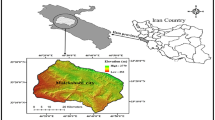Abstract
Eco-environment quality evaluation is an important research theme in environment management. In the present study, Fuzhou city in China was selected as a study area and a limited number of 222 sampling field sites were first investigated in situ with the help of a GPS device. Every sampling site was assessed by ecological experts and given an Eco-environment Background Value (EBV) based on a scoring and ranking system. The higher the EBV, the better the ecological environmental quality. Then, three types of eco-environmental attributes that are physically-based and easily-quantifiable at a grid level were extracted: (1) remote sensing derived attributes (vegetation index, wetness index, soil brightness index, surface land temperature index), (2) meteorological attributes (annual temperature and annual precipitation), and (3) terrain attribute (elevation). A Back Propagation (BP) Artificial Neural Network (ANN) model was proposed for the EBV validation and prediction. A three-layer BP ANN model was designed to automatically learn the internal relationship using a training set of known EBV and eco-environmental attributes, followed by the application of the model for predicting EBV values across the whole study area. It was found that the performance of the BP ANN model was satisfactory and capable of an overall prediction accuracy of 82.4%, with a Kappa coefficient of 0.801 in the validation. The evaluation results showed that the eco-environmental quality of Fuzhou city is considered as satisfactory. Through analyzing the spatial correlation between the eco-environmental quality and land uses, it was found that the best eco-environmental areas were related to forest lands, whereas the urban area had the relatively worst eco-environmental quality. Human activities are still considered as a major impact on the eco-environmental quality in this area.
Similar content being viewed by others
References
Aspinall, R., & Pearson, D. (2000). Integrated geographical assessment of environmental condition in water catchments: linking landscape ecology, environmental modeling and GIS. Journal of Environmental Management, 59(4), 299–319.
Crist, E.P., & Kauth, R.J. (1986). The Tasseled Cap de-mystified. Photogrammetric Engineering and Remote Sensing, 52(1), 81–86.
Dzeroski, S. (2001). Application of symbolic machine learning to ecological modelling. Ecological Modeling, 146(1–3), 263–273.
EOS. (2004). NASA Earth Observing System data gateway. Available at: http://edcimswww.cr.usgs.gov/pub /imswelcome/.
ERDAS, Inc. (1999). ERADS field guide. Atlanta: Georgia.
ESRI, Inc. (2005). ArcInfo. ESRI, CA, USA.
Goh, A.T.C. (1995). Back-propagation neural networks for modeling complex-systems. Artificial Intelligence in Engineering, 9(3), 143–151.
Hao, Y.H., & Zhou, H.C. (2002). A grey assessment model of regional eco-environment quality and its application. Environmental Engineering, 20(4), 66–68. (in Chinese)
Hornik, K. (1991). Approximation capabilities of multilayer feedforward networks. Neural Network, 4(2), 251–257.
Kang, S.M. (2002). A sensitivity analysis of the Korean composite environmental index. Ecological Economics, 43(2–3), 159–174.
Li, A.N., Wang, A.S., Liang, S.L., & Zhou, W.C. (2005). Eco-environmental vulnerability evaluation in mountainous region using remote sensing and GIS — A case study in the upper reaches of Mining river, China. Ecological Modeling (in press).
Liu, Z., Xie, Z.R., & Shen, W.S. (2003). A new method that can improve regional eco-environmental evaluation—combining GIS with AHP. Resources and Environment in the Yangtze Basin, 12(2), 163–168. (in Chinese)
Moisen, G.G., & Frescino, T.S. (2002). Comparing five modelling techniques for predicting forest characteristics. Ecological Modelling, 157(2–3), 209–225.
Niu, W.Y., & Harris, W.M. (1996). China: the forecast of its environmental situation in the 21st century. Journal of Environmental Management, 47(2), 101–114.
Park, Y.S., Chon, T.S., Kwak, I.S., & Sovan, L. (2004). Hierarchical community classification and assessment of aquatic ecosystems using artificial neural networks. Science of Total Environment, 327(1–3), 105–122.
Petersen, W.L. Bertino, Callies, U., & Zorita, E. (2001). Process identification by principal component analysis of river water-quality data. Ecological Modelling, 138(1–3), 193–213.
Qiao, Y.L., Wang, Y., & Tang, J.Y. (2004). Study of remote sensing monitoring of dynamic change of the Loess Plateau forest resources. Advances in Space Research, 33(3), 302–306.
SEPAC. (2005). State Environmental Protection Administration of China. Technical Criterion for Eco-environmental Quality Evaluation.
Shi, Z., Wang, R.C., & Wu, H.H. (1997). GIS-based simulating and mapping of annual mean temperature in mountain area. Mountain Research, 15, 264–268. (in Chinese)
The MathWorks Inc. (1998). User's Guide, Version 3, Neural Network Toolbox for Use with MATLAB.
Wu, J.G., & David, J.L. (2002). A spatially explicit hierarchical approach to modeling complex ecological systems: theory and applications. Ecological Modelling, 153(1–2), 7–26.
Zhang, X.L., You, X.X., Liu, X.S., & Huang, H.G. (2003). A study on forest ecological environment gradient with remote sensing, GIS and expert system. Proceedings of the Second International Conference on Machine Learning and Cybernetics. Xi'an China, 2374–2378.
Zhang, Y.X., Li, H., & Havel, J. (2005). Modeling of the relationship between electroosmotic flow and separation parameters in capillary zone electrophoresis using artificial neural networks and experimental design. Talanta, 65(4), 853–860.
Author information
Authors and Affiliations
Rights and permissions
About this article
Cite this article
Shi, Z., Li, H. Application of artificial neural network approach and remotely sensed imagery for regional eco-environmental quality evaluation. Environ Monit Assess 128, 217–229 (2007). https://doi.org/10.1007/s10661-006-9307-5
Received:
Accepted:
Published:
Issue Date:
DOI: https://doi.org/10.1007/s10661-006-9307-5




